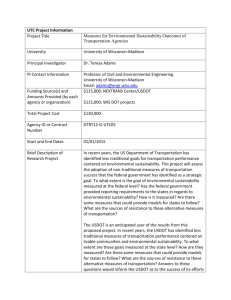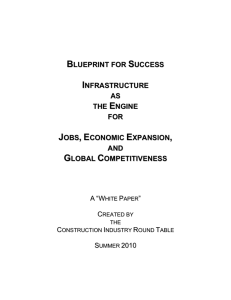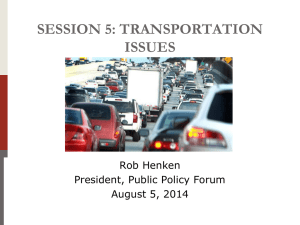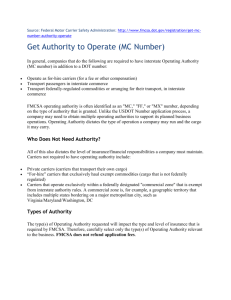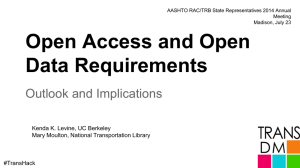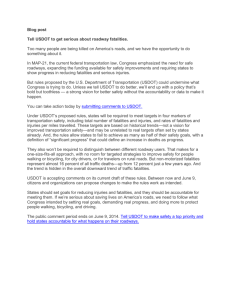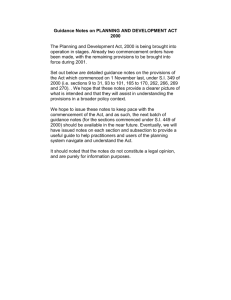1 SPECIAL ALERT: ENVIRONMENTAL PROVISIONS OF THE NEW
advertisement
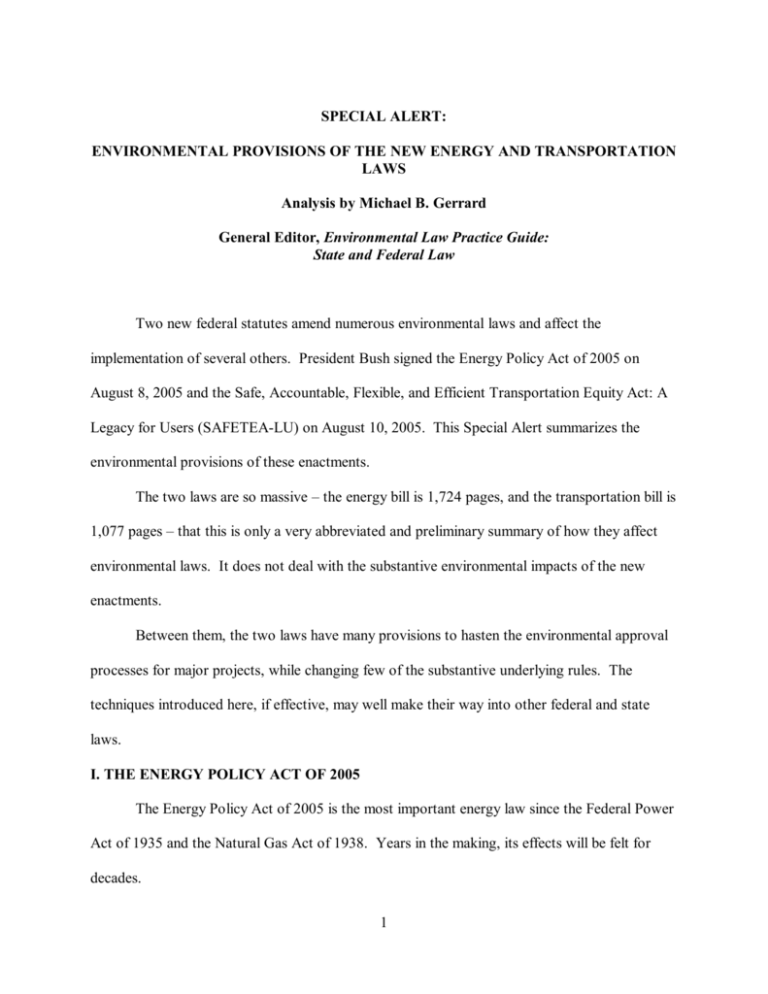
SPECIAL ALERT: ENVIRONMENTAL PROVISIONS OF THE NEW ENERGY AND TRANSPORTATION LAWS Analysis by Michael B. Gerrard General Editor, Environmental Law Practice Guide: State and Federal Law Two new federal statutes amend numerous environmental laws and affect the implementation of several others. President Bush signed the Energy Policy Act of 2005 on August 8, 2005 and the Safe, Accountable, Flexible, and Efficient Transportation Equity Act: A Legacy for Users (SAFETEA-LU) on August 10, 2005. This Special Alert summarizes the environmental provisions of these enactments. The two laws are so massive – the energy bill is 1,724 pages, and the transportation bill is 1,077 pages – that this is only a very abbreviated and preliminary summary of how they affect environmental laws. It does not deal with the substantive environmental impacts of the new enactments. Between them, the two laws have many provisions to hasten the environmental approval processes for major projects, while changing few of the substantive underlying rules. The techniques introduced here, if effective, may well make their way into other federal and state laws. I. THE ENERGY POLICY ACT OF 2005 The Energy Policy Act of 2005 is the most important energy law since the Federal Power Act of 1935 and the Natural Gas Act of 1938. Years in the making, its effects will be felt for decades. 1 Though the new law alters many aspects of federal regulation, it does not aim to effect a basic change in the sources of energy used in the United States. Through a total of $14.5 billion in gross tax breaks over the next 10 years, partly offset by about $3 billion in revenues, it includes substantial subsidies for the coal, oil, natural gas, and nuclear power industries. It mandates research to improve the environmental performance of fossil fuel and nuclear generation, and it has meaningful incentives to build more coal-fired and nuclear power plants. It also provides subsidies for renewable energy, though without many mandates that such energy sources be utilized. The law is not expected to have much effect on oil, gasoline or natural gas prices over the short term. The provision that will be most noticeable to most citizens is Section 110, which mandates an earlier start to Daylight Savings Time. The most radical shift in the law is in Section 1263, which repeals the Public Utility Holding Company Act of 1935. This lifting of restrictions on what kinds of entities may own energy utilities may lead to a wave of purchases by banks, oil companies, and other investors. The statute also includes numerous incentives and subsidies for the use of ethanol, and in that way will benefit many states where crops are grown for conversion into ethanol. Less heralded are the new law’s many changes in the environmental laws, which are the focus here. A. Preemption of State Authority Faced with arguments that state governments were blocking the construction of needed energy infrastructure, Congress has preempted state control over several kinds of facilities. Section 311 gives the Federal Energy Regulatory Commission (FERC) “exclusive authority to approve or deny an application for the siting, construction, expansion, or operation” of liquefied 2 natural gas (LNG) terminals. It establishes a procedure for consulting with the states on state and local safety considerations, but FERC makes the final decisions. Most state control over interstate electric transmission lines is preempted by Section 1221. Congress directed the Department of Energy (DOE) to “designate any geographic area experiencing electric energy transmission capacity constraints or congestion that adversely affects consumers as a national interest electric transmission corridor.” For lines serving such corridors, FERC may issue construction approvals if it finds that the state lacks authority to approve the facility, or the state has withheld approval for more than one year after the application was filed, or has approved the application but has imposed such conditions that the line “is not economically feasible.” This section also makes DOE the lead agency for review of these transmission lines under the National Environmental Policy Act (NEPA), and it requires DOE to ensure that permit decisions and related reviews under all applicable federal environmental laws are completed within one year unless another statute requires a longer time. B. Utility Corridors Utility crossings over federal lands receive special attention. Under Section 368, the Departments of Agriculture, Commerce, Defense, Energy and Interior, in consultation with FERC, states, Indian tribes, local governments, utilities, and others, are directed to designate corridors for oil, gas and hydrogen pipelines and electricity transmission and distribution facilities on federal land, and to perform any environmental reviews that may be required to complete the designation. The statute requires that the designation be done within two years in the 11 contiguous Western states, and within four years in the rest of the country. 3 As a related matter, Section 372 requires DOE, in consultation with the Departments of Interior, Agriculture and Defense, to enter into a memorandum of understanding to coordinate all applicable federal authorizations and environmental reviews related to energy transmission lines and electricity generation and distribution facilities. C. Exemptions from Environmental Laws Several sections of the Energy Policy Act exempt certain energy-related activities from environmental laws, or provide for shortened processes. Under the Safe Drinking Water Act, the U.S. Environmental Protection Agency (EPA) regulates the underground injection of liquids, a method of waste disposal in deep geological formations. Section 322 exempts from this regulatory program the practice of “hydraulic fracturing” – the underground injection of pressurized fluids to fracture the rock and aid the extraction of oil, gas and geothermal energy. This exemption does not apply if diesel fuel is injected, however. EPA regulations under the Clean Water Act impose controls on stormwater from construction sites. Section 323 exempts from this requirement “all field activities or operations associated with exploration, production, processing or treatment operations, or transmission facilities, including activities necessary to prepare a site for drilling and for the movement and placement of drilling equipment.” This expands on an exemption already contained in Section 402(l) of the Clean Water Act (33 U.S.C. § 1342(l)). Section 365 of the Energy Policy Act calls for employees of several federal agencies, including EPA, to be assigned to Bureau of Land Management offices in several Western states under a pilot project to speed the permitting and environmental analysis of energy projects. The new statute outlines several areas of expertise needed in those offices, including the preparation 4 of biological opinions under the Endangered Species Act; issuance of Section 404 permits under the Clean Water Act (33 U.S.C. § 1344); regulatory matters under the Clean Air Act; planning under the National Forest Management Act; and preparation of analyses under NEPA. Section 366 streamlines the permit requirements for natural gas facilities on federal lands. The Secretary of the Interior is given 10 days to notify applicants whether their applications have been rejected. Those facilities not initially approved are given up to two years to meet various requirements, including environmental assessments under NEPA. Section 381 amends the Coastal Zone Management Act (CZMA) by shortening the time frames for appeals of CZMA decisions to the Secretary of Commerce. Unlike most of the environmental provisions in the Energy Policy Act, this amendment applies to all activities reviewed under the CZMA, whether or not they concern an energy project. As a related matter, Section 384 creates a “Coastal Impact Assistance Program” under the Outer Continental Shelf Lands Act for the federal government to share lease revenues with the states and municipalities near leased areas. This primarily relates to offshore oil and gas production. NEPA analysis is also affected by Section 390, which creates a rebuttable presumption that a categorical exclusion under NEPA would apply to certain activities conducted pursuant to the Mineral Leasing Act for the purpose of exploration or development of oil or gas. This section applies to actions by the Secretaries of the Interior and of Agriculture in managing the public lands and the National Forest System lands, respectively. For such actions, the categorical exemption applies to surface disturbance of less than five acres, drilling of oil or gas wells at sites where drilling took place within the past five years, and drilling of wells within a developed field for which an approved land use plan or any NEPA document was prepared. 5 Section 752 requires EPA to launch what may become a controversial investigation into the trading of mobile source emission reduction credits for use by owners and operators of stationary source emission sources to meet emission offset requirements within areas that are nonattainment under the Clean Air Act. This would allow stationary sources (such as factories and power plants) to avoid reducing their air emissions if they arrange for mobile sources (such as vehicles) to emit less. D. Underground Storage Tanks Sections 1521-1533 are an extensive set of amendments to the Resource Conservation and Recovery Act (RCRA), and are denominated the Underground Storage Tank Compliance Act. Leaking underground storage tanks (USTs) are a major source of groundwater contamination. Among the provisions are the following: o Funding to the states for UST enforcement and cleanup programs; o Requiring periodic EPA or state inspections of regulated USTs; o Requiring training of UST operators and maintainers; o Funding for inspections and other enforcement actions; o Requiring states that receive federal UST funding to submit state compliance reports; o Requiring states to maintain and update a record of regulated USTs, and their compliance records; o Providing for EPA and the states to restrict what materials can be delivered to USTs; o Providing for federal facility compliance with federal, state and local UST regulations; o Requiring new and replacement USTs, and connecting piping, to have secondary containment and leak monitoring, if located near a water supply; 6 o Requiring new motor fuel dispenser systems to have spill containment, if located near a water supply; and o Requiring manufacturers and installers of USTs or piping to demonstrate financial responsibility, so they can pay for corrective action if necessary. E. Alternative Energy and Clean Fuels Several sections of the law extend through 2007 the tax credits for wind, biomass, geothermal, small irrigation power, landfill gas, and trash combustion production. Other sections, too numerous to catalog here, deal with alternative and clean fuels and energy sources. For example, Section 712 encourages domestic production and sales of efficient hybrid and advanced diesel vehicles. The law also provides for a fuel cell transit bus demonstration program (Section 731), a clean school bus program using alternative fuels (Section 741), and a diesel truck retrofit and fleet modernization program (Section 742). Sections 801-816 encourage the use of hydrogen and fuel cells. (As noted below, the new transportation law has additional provisions along similar lines.) F. Energy Conservation/Green Buildings Many sections of the law address energy conservation in buildings, appliances, and other uses. Of particular note are Section 109, which requires DOE to establish revised federal building energy efficiency performance standards, and Section 125, which provides grants to the states to assist municipalities in improving the energy efficiency of public buildings and facilities. G. MTBE Final passage of the Energy Policy Act was delayed many months by controversy over methyl tertiary butyl ether (MTBE), a gasoline additive that was designed to reduce air pollution 7 but also resulted in creating widespread groundwater contamination. Some members of Congress advocated a limitation on liability for MTBE contamination for oil companies that included MTBE in their fuel, and for chemical manufacturers that made MTBE. In the end, the law as enacted did not contain this limitation. However, Section 1503 provides that claims and legal actions filed after the date of enactment of the new law (August 8, 2005) that related to actual or threatened MTBE contamination may be removed from state court to the appropriate federal district court. Section 1504 repeals the 2% oxygenate requirement for reformulated gasoline sold in the nation’s most polluted areas. H. Global Climate Change The environmental community called for numerous measures to reduce emissions that contribute to global climate change. Few such measures were in the final bill. However, Title XVI, “Climate Change,” calls for work on strategies to reduce greenhouse gas intensity. Section 1610(a)(6) defines “green house gas intensity” as the “ratio of green house gas emissions to economic output.” Title XVI focuses on the development and deployment of technologies to reduce greenhouse gases. I. Nuclear The new act reauthorizes the Price-Anderson Act, an important liability protection for the nuclear industry. One subtle change that is relevant to environmental lawyers is in Section 651, which (among many other things) amends the definition of “byproduct material” regulated by the Nuclear Regulatory Commission to include any material that has been made radioactive by the use of a particle accelerator; certain discrete sources of radium-226; and discrete sources of naturally occurring radioactive material that pose a threat similar to that of radium-226. The 8 same section removes certain byproduct material from the definition of “low level radioactive waste.” J. Provisions Not Included In addition to more extensive changes in the law on MTBE and global climate change, many other much-discussed provisions were not in the final legislation. Environmentalists wanted improved fuel economy standards for automobiles, pickup trucks and SUVs; these were not enacted. They also wanted a Congressionally-mandated renewable electricity standard, which would have required electric utilities to generate or purchase more renewable energy. This too was not enacted, though Section 203 calls for increases in the amount of electricity consumed by the federal government from renewable sources to not less than 7.5% in Fiscal Year 2013 “to the extent economically feasible and technologically practicable.” The definition of “renewable energy” applicable to this section includes not only solar, wind, ocean energy, and geothermal, but also more controversial sources, such as municipal solid waste and new hydroelectric facilities. Energy producers had also hoped for two provisions that proved extremely controversial, and were not enacted: authorization of oil drilling in the Arctic National Wildlife Refuge, and exemption of some communities from clean air standards. II. THE SAFE, ACCOUNTABLE, FLEXIBLE, AND EFFICIENT TRANSPORTATION EQUITY ACT: A LEGACY FOR USERS (SAFETEA-LU) SAFETEA-LU is a six-year transportation authorization law that succeeds the Transportation Equity Act for the 21st Century (TEA-21) of 1998. The prior law expired on 9 September 30, 2003; since then Congress had to pass 12 stop-gap measures to keep federal transportation money moving to state and local agencies. The new enactment lists more than 6,000 named projects for funding, ranging from highway segments to bicycle trails, bus terminals, ferry terminals, and museum renovations. In all the new law authorizes $286.4 billion in federal expenditures. A. Environmental Reviews From an environmental law perspective, the most important part of SAFETEA-LU is probably Section 6002, “Efficient Environmental Reviews for Project Decisionmaking.” It aims to expedite the NEPA process and any subsequent litigation. It provides that, for highway projects with federal funding, the U.S. Department of Transportation (USDOT) is always the federal lead agency for NEPA review. If a state or local government entity is sponsoring the project, it will serve as a joint lead agency with USDOT. Section 6002 resolves several questions that were often litigated. It says that a sponsoring state or local agency may prepare the environmental review documents, and that the preferred alternative course of action may be identified during the process and analyzed at a higher level of detail than the other alternatives. In an effort to move the NEPA process more swiftly, Section 6002 not only allows lead agencies to establish a schedule for completion of the process – it also mandates that decisions under any federal law related to a project must be made within 180 days after USDOT has made all its final decisions. To the extent that any federal agency is late, USDOT is directed to inform the Congressional highway committees, and every 60 days thereafter USDOT must send the committees the number of decisions of the delinquent agency that remain outstanding, and must also publish this information in the Federal Register. 10 Section 6002 also provides a procedure for resolving interagency disputes about highway projects. This appears to be aimed at the occasional situation where EPA, the Fish and Wildlife Service, or another agency is critical of a highway plan. If the participating agencies disagree about a project, then at the request of a project sponsor, or the governor of the state where the project is located, USDOT must convene a meeting of the relevant participating agencies “to resolve issues that could delay completion of the environmental review process or could result in denial of any approvals required for the project.” If resolution cannot be achieved within 30 days after the meeting, the lead agency must notify the agencies, the governor, the Congressional committees, and the President’s Council on Environmental Quality, and publish notice in the Federal Register. Once a final decision is made, Section 6002 greatly shortens the time when a legal challenge may be brought. Currently a six-year statute of limitations generally applies to federal lawsuits under NEPA (though the doctrines of laches and mootness often require faster action). The new law establishes a 180-day statute of limitations for any “claim arising under Federal law seeking judicial review of a permit, license, or approval issued by a Federal agency for a highway or public transportation capital project.” The clock starts when notice of the decision appears in the Federal Register. The statute provides, however, that “[n]othing in this section affects any existing State environmental review process.” Two other sections expand state authority in the NEPA process. Section 6003 establishes a pilot program for full delegation of federal permit streamlining authority in up to five states. Section 6004 allows USDOT to grant to any state the authority to create categorical exemptions from NEPA. 11 Other parts of SAFETEA-LU exempt certain actions from NEPA altogether. Section 3006 provides that decisions by USDOT concerning metropolitan or statewide transportation plans, or transportation improvement projects, are not subject to NEPA. Section 6010 requires USDOT to establish categorical exclusions for activities that support the deployment of “intelligent transportation infrastructure and systems.” B. Historic Preservation and Section 4(f) of the Department of Transportation Act One of the most important environmental laws in the transportation area is known as Section 4(f) of the Department of Transportation Act (though it is now codified at 49 U.S.C. § 303 and 23 U.S.C. § 138). It inhibits USDOT participation in any action “which requires the use of any publicly owned land from a public park, recreation area, or wildlife and waterfowl refuge … or any land from an historic site … unless … there is no feasible and prudent alternative to the use of such land.” Section 6009 amends Section 4(f) in several ways. Most importantly, it allows for an exemption from Section 4(f) for projects that USDOT determines will have minor or “de minimis” impacts. For historic resources, this requires the concurrence of state and federal historic preservation officials. This concurrence is obtained through the consultation process of Section 106 of the National Historic Preservation Act (16 U.S.C. § 470f). For parks, recreation areas, and wildlife and waterfowl refuges, the officials with jurisdiction over those areas must concur, after notice and opportunity for public comment. The new law also requires USDOT to promulgate regulations “that clarify the factors to be considered and the standards to be applied in determining the prudence and feasibility of alternatives” under Section 4(f). 12 Section 6007 exempts the Interstate Highway System as a whole from consideration as an historic resource, though individual elements, such as historic bridges, may be considered. C. Planning Existing statutes established an elaborate planning process for federal transportation expenditures. Section 3005 modifies this process at the metropolitan planning level. It lists the factors that must be considered in assessing projects and strategies (such as safety, security, accessibility, economic vitality, and environmental protection), but it says that failure to consider any of these factors is not reviewable by any court under the Administrative Procedure Act. Section 3005 also provides that long-range transportation plans “shall include a discussion of types of potential environmental mitigation activities and potential areas to carry out these activities.” These mitigation measures must be developed in consultation with federal, state and tribal wildlife, land management, and regulatory agencies. It also requires public participation in the planning process, and it says that public information must be posted on the Web. Section 3006 has similar provisions for statewide transportation planning. Public participation is also encouraged by Section 3024, which provides that in the review of capital projects, USDOT must ensure that there has been an adequate opportunity for public participation, and that the project application includes a record of the project’s environmental impact, adverse environmental effects, alternatives, and irreversible and irretrievable impacts. It also requires USDOT to issue environmental findings. In aid of the environmental assessment process, Section 5207 requires USDOT to establish a Surface Transportation Environment and Planning Cooperative Research Program. Among the topics it may research are ways “to develop more accurate models for evaluating 13 transportation control measures” and “to improve understanding of the factors that contribute to the demand for transportation.” D. Conformity An associated planning process under Section 176 of the Clean Air Act (42 U.S.C. § 7506) is designed to ensure that transportation projects conform to air pollution control requirements. Section 6011 amends this process in several ways. It reduces the frequency for making conformity determinations on updated transportation plans and programs from once every three years to once every four years. It sets the conformity horizon for transportation plans as at least 10 years, or longer at the election of the metropolitan planning organization. Section 6011 also sets forth the circumstances under which transportation control measures that are specified in an implementation plan may be replaced or added. E. Diesels and Clean Fuels Like the Energy Policy Act, SAFETEA-LU encourages the development of clean diesel and alternative fuel technologies and vehicles. Section 1808 gives a priority for funding under the Congestion, Mitigation and Air Quality (CMAQ) program to diesel retrofit projects “and other cost-effective emission reduction activities” and “cost-effective congestion mitigation activities that provide air quality benefits.” It also requires EPA to publish a list of diesel retrofit technologies. The statute creates a clean fuels grant program, encouraging buses that use compressed natural gas, liquefied natural gas, biodiesel fuels, batteries, alcohol-based fuels, hybrid electric, fuel cell, clean diesel, or “other low or zero emissions technology” (Section 3010); a National Fuel Cell Bus Technology Development Program (Section 3045); a study of the actions necessary to facilitate the purchase of increased volumes of alternative fuels for use in public 14 transit vehicles (buses, trains and ferries) (Section 3016); and a Clean School Bus Program (Section 6015). Section 1121 authorizes states to allow vehicles certified as low-emission and energyefficient to use high-occupancy vehicle lanes, even if there are no passengers. F. Brownfields Grants Section 1956 amends the Comprehensive Environmental Response, Compensation and Liability Act (CERCLA) by allowing potentially responsible parties to receive federal brownfields grants and loans to allow them to qualify as bona fide prospective purchasers, if they acquired the property on or before January 11, 2002. This would allow the money to be used, for example, to satisfy the “appropriate care” element of this CERCLA defense. G. Recycling Several sections encourage the recycling or reuse of materials. Section 1805 provides that any state that demolishes a bridge or overpass under a federal program must make the debris available for beneficial use by a federal, state or local government. Section 6014 encourages the federal procurement of recycled coolants. Section 6017 amends the Resource Conservation and Recovery Act to require increased use of the recovered mineral component in federally funded projects involving the procurement of cement or concrete. It applies to blast furnace slag, coal combustion fly ash, silica fume, and other such waste material. H. Hazardous Materials Transportation 15 Sections 7001-7133 enact the Hazardous Materials Transportation Safety and Security Reauthorization Act of 2005. This adopts various technical amendments to the existing laws on hazmat transportation, and it also: o adds provisions for background checks for drivers hauling hazardous materials; o enhances government authority to discover hidden shipments of hazardous materials; and o gives certain responsibilities to the Department of Homeland Security. I. Sanitary Food Transportation Sections 7201-7204 enact the Sanitary Food Transportation Act of 2005. This law is designed to ensure the cleanliness of bulk vehicles such as tanker trucks and hopper cars that haul food, where the food (such as milk or grain) comes into direct contact with the vehicle interior. _____________________________ Michael B. Gerrard is a partner in the New York office of Arnold & Porter LLP. He was the 2004-2005 chair of the American Bar Association’s Section of Environment, Energy and Resources. He has also taught environmental law at Columbia Law School and the Yale School of Forestry and Environmental Studies. He is the General Editor of the Environmental Law Practice Guide: State and Federal Law (11 volumes), and of Brownfields Law and Practice: The Cleanup and Redevelopment of Contaminated Land (four volumes), and is a co-author of Environmental Impact Review in New York (two volumes). All are published by LexisNexis Matthew Bender. 16
